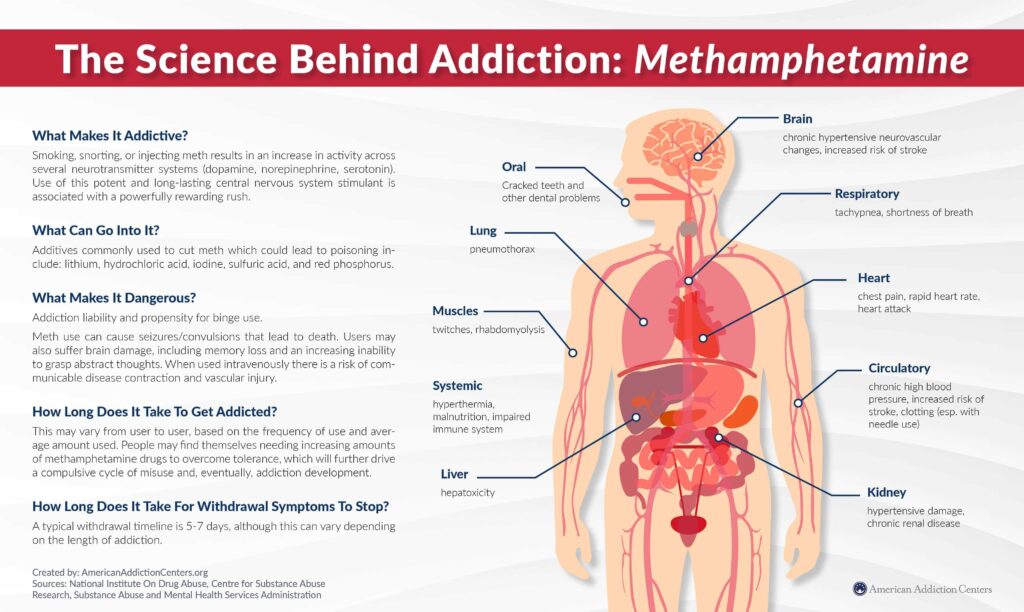Meth Addiction: Signs, Effects, and Treatment
What Is Meth?
Classified by the United States Drug Enforcement Administration (DEA) as a Schedule II substance, methamphetamine carries a significant potential for misuse and serious physiological and psychological dependence.3
Though pharmaceutical methamphetamine is still in production, much of the street supply of meth is illicitly manufactured—often found in powdered form—as shiny glass fragments or as whitish crystalline rocks (crystal meth). Meth is a chemical derivative of amphetamine, another stimulant substance that, in pharmaceutical formulations, is approved for the treatment of conditions such as attention-deficit hyperactivity disorder (ADHD) and the sleep disorder narcolepsy.1
There are a variety of methods in which people can use methamphetamine. Individuals who smoke meth report a euphoric “rush,” an intense pleasurable feeling that only lasts a couple of minutes, which contributes to its addictive potential since individuals may try to maintain the high by repeatedly using more meth.4,5 Individuals who use meth via injection report similarly quick-onset, euphoric effects. Those who snort it or take it orally experience the euphoria relatively more gradually, with less of a pronounced initial rush.4,5
Short-Term Health Effects and Risks of Meth Use
Besides the euphoric high, meth is associated with other health effects and risks. It increases wakefulness and physical movement but suppresses an individual’s appetite. Other short-term effects of meth that can negatively impact an individual’s physical and mental health include:6
- Rapid and irregular heartbeat.
- Elevated blood pressure.
- Increased rate of breathing.
Hyperthermia, a dangerously high body temperature, and convulsions can occur with methamphetamine overdose, which, left untreated, can be fatal.6
Methamphetamine Overdose
Taking too much meth, using meth in combination with other substances, or ingesting meth adulterated with other drugs, like fentanyl, can increase the risk of toxicity and fatal overdose.7 A study by the National Institute of Health showed that methamphetamine-related overdose deaths almost tripled between 2015 and 2019.7 Additionally, during this 5-year period, the number of overdose deaths involving psychostimulant drugs other than cocaine (primarily methamphetamine) increased by 180%, while the number of individuals reporting methamphetamine use only rose 43% during the same period.7
Methamphetamine overdose—without the presence of additional substances—can lead to devastating cardiovascular events such as stroke and heart attack, as well as additional organ damage.1 Other signs of stimulant toxicity—like meth—alone, include:8,9
- Confusion.
- Psychosis.
- Seizures.
- Rapid increase in heart rate, blood pressure, and body temperature.
- Chest pain.
- Circulatory collapse.
- Death.
Taking meth with other substances can be incredibly dangerous. Fentanyl, which can be lethal in even small amounts, is often mixed with meth since it looks just like meth in its powdered form.10 Fentanyl-involved overdoses can cause slowed or stopped breathing and death. If you suspect someone is overdosing, call 911 immediately, and administer naloxone, if available. Naloxone can reverse an opioid overdose but won’t harm a person who didn’t ingest opioids.10
Long-Term Effects and Risks of Meth Use
Over time, more chronic use of meth can result in significant physical and psychological problems, which may include:1,8,11
- Cumulative brain changes resulting in confusion, memory loss, and impaired verbal learning.
- Reduced coordination.
- Insomnia.
- Changes in mood.
- Violent behavior.
- Chronic anxiety.
- Paranoia.
- Hallucinations.
- Extreme weight loss.
- Severe heart problems, (e.g., chronic systemic and pulmonary hypertension, cardiomyopathy, increased chance of aortic dissection, and myocardial infarction)
- Skin abscesses and damaged blood vessels (from injection use).
- Severe dental problems such as gum disease and tooth decay.
Additionally, individuals who inject meth are at an increased risk of contracting certain blood-borne diseases, such as HIV and hepatitis B and C.1 Studies indicate that meth use may worsen the progression of HIV/AIDS and its health consequences.1 Furthermore, research suggests a potential association between past meth use and Parkinson’s disease.1
Is Meth Addictive?
Meth is extremely addictive. Meth use increases the activity of several neurotransmitters, including dopamine, a brain chemical important for motivation and the reinforcement of rewarding behaviors.1 Meth’s quick release of significant amounts of dopamine in the brain’s reward centers reinforces drug-taking behaviors.1
Also, as previously mentioned, individuals who smoke or inject meth experience a surge of euphoria that fades quickly—even before the drug reaches the bloodstream. Thus, these individuals often use meth in a “binge-and-crash pattern,” meaning they try to maintain the high by taking more of the drug. In some cases, they may forgo sleeping and eating while continuing to take meth for several consecutive days. This is known as a “run.”4
In 2022, 2.7 million Americans aged 12 or older reported using meth. That same year, 1.8 million individuals aged 12 or older had a diagnosable methamphetamine use disorder.2

Methamphetamine addiction impacts many different parts of the body including; the muscles, liver, brain, mouth, heart, circulatory system, and respiratory system.
Meth Addiction Symptoms
While meth is highly addictive, not everyone who uses it becomes addicted to it. Signs of meth use—such as decreased fatigue, nervous scratching, and irritability—don’t necessarily indicate a substance use disorder, the clinical term for addiction.8
Meth Withdrawal
When an individual uses meth chronically over a prolonged period, they may develop a physiological dependence to the drug, meaning their brain and body have become so used to having meth present in the system that the brain and body need it to function normally. If use suddenly stops or drastically decreases, withdrawal symptoms surface.13
While withdrawal from stimulants like meth is rarely dangerous or life-threatening, it can be severely unpleasant and psychologically challenging.13,14 Symptoms of withdrawal from stimulants, such as meth, frequently start within 2 to 4 days after an individual stops or drastically reduces their prolonged meth use and last for several days. However, fatigue, depressed mood, anxiety, cravings, and concentration difficulties may persist for up to 4 weeks.8
Some common meth withdrawal symptoms include:1,8
- Mental and physical fatigue.
- Extreme sleepiness or insomnia.
- Intense dreams or nightmares.
- Irritability.
- Mood swings.
- Anhedonia (loss of interest in previously enjoyable activities).
- Depression.
- Anxiety.
- Severe craving for the drug.
- Weight gain and hunger.
Medical detox is not usually required for stimulant-only use; however, it may be recommended if other drugs—such as are alcohol, opioids or benzodiazepines—are involved since these drugs have severe withdrawal symptoms that may complicate detox.It may also be recommended if you experience psychiatric symptoms that can complicate withdrawal.14
While there are no medications approved by the Food and Drug Administration (FDA) to treat stimulant withdrawal, medications may be prescribed on an off-label, substance-specific basis to treat the symptoms associated with withdrawal—such as anxiety, depression, and insomnia—as well as to help reduce use and promote abstinence.1,8,15
Meth Addiction Treatment
The setting, approach, and duration of treatment for meth addiction varies depending on the individual’s specific needs.14 A doctor or other healthcare professional can help determine the best level of care for you or your loved one. A treatment plan often involves more than one type of treatment on the continuum of care, which may include:1,16
Inpatient or residential treatment. Inpatient or residential options involve you staying at a 24-hour facility with intensive professional care, including medical supervision. There, you will likely participate in education sessions, individual and group counseling, and behavior therapies. Common behavior therapies used in meth addiction treatment include cognitive-behavioral therapy (CBT)—which teaches skills to help you identify situations that lead to meth use and replace negative thought patterns and coping mechanisms—and motivational incentives, which encourages abstinence by rewarding drug-free behaviors with vouchers or other incentives.
Outpatient treatment. Outpatient programs look similar to inpatient treatment but allow you to live at home or in a sober living environment and travel to the treatment facility to attend counseling and therapy sessions at specific times.
Aftercare. Aftercare services or ongoing treatment provides the best chances of avoiding future relapse. Aftercare may include community-based and family-based support systems, mutual-help groups, alumni events, and more.
Effective treatment addresses the entire spectrum of physical problems and personal difficulties that have resulted from long-term meth use.1
If you have a loved one struggle with meth addiction, call American Addiction Centers (AAC) today. Let one of our experienced and compassionate admissions navigators listen to your story, answer your questions, check your insurance benefits, and help you start treatment today.
